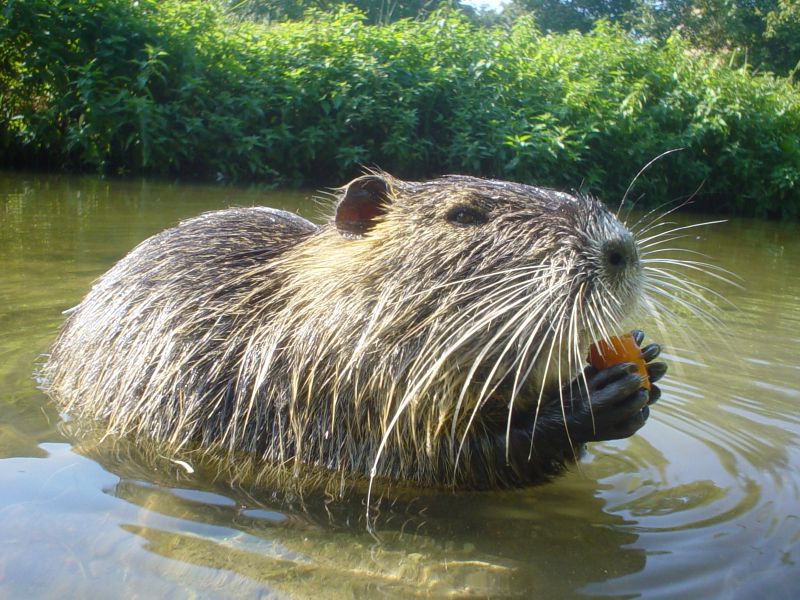
Coypu, or River rat, or Nutria(Myocastor coypus)
Phylum —chordata
Class — mammalia
Order — rodentia
Family —echimyidae
Genus – myocastor
Appearance
Coypu looks like a large, robust rat. Its body is highly arched, and the head is large and almost triangular. The ears and eyes are small and are located in the upper part of the head. The incisors are broad, with orange-pigmented anterior surfaces. The legs are short. The hind feet are much longer than the forefeet, and contain five digits; the first four are connected by webbing, and the fifth is free. The forefeet have four long, flexible, unwebbed digits and a vestigial thumb. The tail is long and rounded. The pelage consists of two kinds of hair, soft dense underfur, and long coarse guard hairs that vary from yellowish brown to reddish brown. The underfur is dark gray, and it is denser on the abdomen. The chin is covered by white hairs, and the tail is scantily haired.
Males are generally larger than females. The length of the head and body is 521 mm (472-575), and the length of tail is 375 mm (340-405).
Habitat
Native to South America, this species occurs from middle Bolivia and southern Brazil to Tierra del Fuego. Coypus are also found in Europe, Asia and North America as a result of numerous escapes and liberations from fur farms.
Behavior
Coypus are highly sociable animals, forming family groups of 2-13 individuals, usually consisting of an adult male and multiple related females with their young. Young adult males can sometimes be solitary. These animals are neither migratory nor nomadic. They live in the same area throughout their lives. As semi-aquatic animals, Coypus are able to remain underwater for over 10 minutes at a time. This species is nocturnal. Period of increased activity occurs at night, when animals swim, feed and groom. Feeding and grooming takes place in special platforms, which they construct out of vegetation. They also make burrows, where they find shelter. These dens may be either simple tunnels or a tunnel system, consisting of multiple long passages of over 15 meters as well as nesting chambers. These animals are also known to make paths through the grass, travelling around their dens within a radius of 180 meters.
Diet
These herbivorous animals mainly feed upon stems, leaves, roots, bark and other aquatic vegetation, supplementing their diet with floating objects such as logs.
Reproduction
Coypus are through to have a polygynous mating system, where pairs disperse right after mating. These highly productive animals mate at any time of year. Gestation period lasts for 127-139 days, yielding a litter of up to 13 young with an average of 3-6. After giving birth, the female may mate again. Thus, she is able to produce young 3 times per year. Offspring of this species are born with their fur and open eyes.
Females reach sexual maturity at 3 months old, whereas males are mature a bit later - at 4 months of age. Sometimes the age of sexual maturity may delay to up to 9 months old.
The potential longevity of Myocastor coypus is 6 years.
In captivity
When the first Nutria is taken, everything should be ready: housing, food supplies and an equipped reservoir.
Conditions for keeping Nutria:
- One individual should have 70-80 liters of water for swimming. The water in the reservoir must be clean. Change the water every 2 days.
- When kept in cages, each pair should have at least 1 sq. m.
- In the room a comfortable temperature should be maintained for animals-15-25 °C.
- Animals should receive a balanced diet and fresh water.
Nutria must be provided with:
- A warm room. In winter, you cannot keep Nutria outside. Animals patiently endure severe frosts, but they should not be tested for strength. In cold weather, rodents do not want to eat – they hid themselves in the bedding. And babies born in the cold can die a few hours after birth. To save the livestock, it is transferred to a warm room with a thick layer of litter for the winter.
- Reservoir. The animals can do without it. The lack of water negatively affects the health of semi-aquatic animals. It is advisable to equip at least a small pool.
Feeders and drinkers are necessary for the keeping of Nutria. You can buy them or make them yourself. For water delivery, any container is suitable, but the most convenient is an automatic drinker.
The diet of Nutria varies depending on the time of year. Food is selected taking into account the needs of animals and the availability of seasonal feed. What is not available in winter, in summer you can find cheap or even for free.
 Russian
Russian
 English
English
























